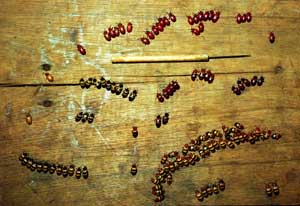|
|
 27 polymorphic species DHJanzen100190.jpg high resolution
|
|
| When one collects a large number of the Arescus beetles from many rolled leaves, and groups them by color pattern as in this image, it becomes clear that there are many patterns and that they are not all equally abundant. The proportions of different species could be due to differential selection for or against different patterns, or the complexity of the genetic programming, or both. Here, I would like to address what is a possible selective pressure favoring the polymorphism per se. The models for these mimetic beetles (see later images) are moderately abundant (in the sense of being seen walking ostentatiously about on the foliage) in the rainforest understory where the mimics and their Heliconia food plants occur. However, the mimic Arescus are extremely abundant as well, if we count absolute abundance (those in the rolled leaves). This jars because when mimics begin to approach their models in abundance, it is easy to visualize that the predators (birds) would encounter them sufficiently frequently, and thus sample them frequently, that they could well learn to discriminate and that would be the end of the very visible mimics. However, to the bird, the mimic Arescus are in fact very rare, because they are only visible to the bird when they (rarely) fly or walk from the newly opening rolled leaf in search of another newer leaf in which to pass the days. If, they are polymorphic, then they become effectively yet much rarer, since the predator sees a yellow beetle, and red and black beetle, and a yellow and black beetle as three different beetles rather than one and the same (as does the taxonomist). In effect a population of Arescus is mimicking a suite of about ten quite differently-colored species of models, and thus is only a tenth as abundant in the eyes of the predator as it actually is during its exposure to predators. All of these beetles were in the rolled leaves of a single species (Heliconia imbricata) and there is a second species of Arescus, equally polymorphic, that lives in the rolled leaves of a second species of Heliconia. | ||
back to lecture slides
or skip to: